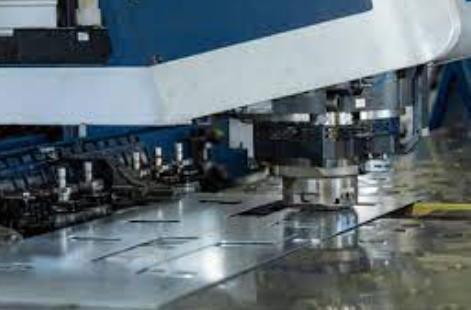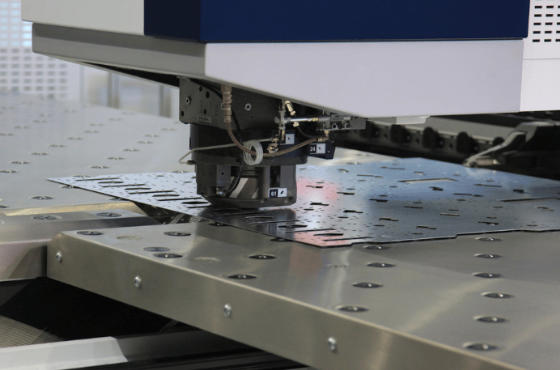Views: 222 Author: Rebecca Publish Time: 2025-11-17 Origin: Site









Content Menu
● Introduction to Punch Press Machines
● Role of Punch Press Machines in Tableware Manufacturing
● Essential Characteristics of a High-Precision Punch Press
>> 2. Precision Slide Guidance
>> 3. Consistent Force Control
>> 4. Intelligent Control Systems
>> 5. High-Quality Tooling System
● Comparing Different Types of Punch Press Machines
● Advanced Automation in Tableware Manufacturing
>> Key Automation Integrations:
● Material Precision: Challenges and Solutions
● Sustainability and Energy Efficiency in Modern Press Lines
● Maintenance Practices for Long-Term Precision
● Case Study: Increasing Forming Consistency in Stainless Steel Tableware
● Future Trends in Punch Press Technology
>> Integration with Industry 4.0
● Technological Comparison Chart
● FAQ
>> 1. What are the benefits of servo punch presses over traditional mechanical types?
>> 2. How do punch press machines ensure consistency across batches?
>> 3. Are automated punch press lines cost-effective?
>> 4. What kind of maintenance schedule is best for a precision punch press?
>> 5. How does punch press technology affect sustainability in the tableware industry?
In today's competitive manufacturing landscape, high-precision production defines the success of modern factories. Among the various machines used in shaping, forming, and cutting metal products, the punch press machine stands out for its efficiency and accuracy. Whether manufacturing stainless steel tableware, aluminum foil dishes, or decorative metal utensils, selecting the right punch press equipment determines not only the precision of each piece but also the overall profitability and sustainability of production lines.
This article explores what makes a punch press machine ideal for high-precision applications in the tableware manufacturing industry. It examines design features, production performance, automation trends, and real-world examples that highlight the role of this crucial technology.

A punch press machine is an industrial tool that uses controlled mechanical or hydraulic force to cut, stamp, or form materials into specific shapes. In tableware production, punch presses create precise components such as plate bodies, utensil handles, cookware lids, and decorative embossed designs.
The press operates by driving a punch (attached to the upper ram) into a die (mounted on the press bed) with great force. By repeating this motion at high speeds, the machine can produce thousands of identical parts each hour. Depending on the application, manufacturers can choose between mechanical, hydraulic, or servo-driven punch presses to achieve the perfect balance between speed, power, and precision.
Punch press machines form the backbone of many tableware production lines. In a typical stainless steel or aluminum tableware factory, they are used in several stages:
- Blanking: Cutting raw sheet metal into precise blanks that form the base of dishes or utensils.
- Forming: Shaping blanks into final or semi-finished forms using controlled force.
- Piercing: Creating holes or slots for mounting, assembly, or decorative features.
- Embossing: Adding detailed textures or designs to enhance the appearance of the product.
- Trimming: Removing excess material around edges to create smooth, safe finishes.
Each of these operations requires a precise sequence of movements and controlled power application. Even a small deviation during press operation can cause dimensional errors, burrs, or cracks, which reduce product quality and increase waste. Hence, precision engineering becomes the cornerstone of efficient tableware production.
The structural rigidity of the frame ensures stability during high-speed operations. Advanced punch press machines feature monoblock or welded structures that resist deformation and vibration. In tableware production, this rigidity allows manufacturers to maintain accuracy even when working with thin stainless steel sheets that are prone to bending.
A rigid structure also extends machine lifespan since it reduces internal stress on components like bearings and drive shafts.
The ram or slide of the press must travel along a precise vertical axis to align perfectly with the die. Modern machines use multi-point slide guide systems or hydrostatic bearings to maintain exact alignment under heavy loads. With precise guidance, manufacturers achieve consistent wall thickness in bowls, clean edges in plates, and symmetrical details in embossing operations.
Uniform pressure throughout the stroke cycle prevents uneven deformation. Servo punch press models deliver precise torque control, which means forming pressure can be adjusted dynamically throughout each motion. This is particularly important for forming thin or coated materials, such as non-stick cookware surfaces, where excessive force could damage coatings.
Today's high-precision presses are equipped with computer numerical control (CNC) systems and programmable logic controllers (PLC). These digital control platforms let operators adjust speed, stroke length, and load profiles with exceptional accuracy.
Manufacturers can store customized press programs for different tableware types, reducing setup time and minimizing human error. The integration of smart monitoring tools also allows operators to track temperature, tonnage, and vibration levels in real-time.
Tooling precision determines how well each press stroke translates into a perfect part. High-performance tools made from hardened tool steels or tungsten carbide provide outstanding durability and edge retention.
In decorative tableware, where dies must form fine patterns or engraving, polishing and alignment accuracy of tooling are essential. Modern quick-change tooling systems now allow operators to swap dies within minutes, boosting production flexibility.
Mechanical presses deliver rapid operation through flywheel energy transfer. Their high-speed capability makes them ideal for punching, blanking, or shearing operations in aluminum plates and disposable foil packaging.
While mechanical presses have a fixed stroke and limited flexibility, their simplicity and speed make them cost-effective for large-scale, uniform part production.
Servo technology has revolutionized metal forming. Servo presses combine mechanical strength with digital precision, allowing complete control over stroke motion and pressure application. This makes them ideal for both thick and thin materials and for applications requiring complex forming curves such as deep-drawn stainless steel bowls or embossed dish covers.
Servo presses operate quietly, consume less energy, and extend tool life through smoother motion control, making them an attractive investment for eco-conscious manufacturers.
Hydraulic presses are unmatched for forming thick or multi-layered materials. Their ability to exert constant pressure across long strokes makes them suitable for deep-drawing cookware, pans, and serving trays.
Although slower than mechanical presses, hydraulic models deliver excellent surface finishes and precise forming depths, which are critical in high-end tableware products.

Automation now defines the modern metalworking facility. Automated feeding systems, robots, and conveyor lines seamlessly integrate with punch presses to improve production flow and reduce manual handling.
- Automatic sheet feeders ensure uniform material input at high speed.
- Robotic arms handle finished parts, preventing surface damage.
- Vision systems inspect parts for quality before stacking or further processing.
- IoT connectivity enables real-time data tracking, predictive maintenance, and efficiency analysis.
For large factories producing stainless steel plates or aluminum containers, automation allows 24/7 operation without sacrificing precision, greatly improving return on investment.
Precision production demands understanding the forming characteristics of various tableware materials:
- Stainless steel (304, 316 grades): Requires precise force control due to hardness and spring-back characteristics. Servo presses are ideal.
- Aluminum alloys (e.g., 3003, 8011): Lightweight and ductile; suitable for deep drawing but sensitive to tool misalignment.
- Copper and coated steel: Need protective handling to avoid surface scratches or material delamination.
To achieve high precision, manufacturers must ensure lubricants are clean, dies are polished, and temperature control maintains consistent material behavior throughout production.
Energy-saving technology has become fundamental in modern machinery design. Traditional mechanical presses continuously spin their flywheels, consuming power even when idle. By contrast, servo presses draw energy only during active motion. This can reduce power consumption by up to 40 percent.
Regenerative braking systems, commonly used in advanced servo presses, capture and store kinetic energy during the deceleration phase, further reducing electricity usage. In large-scale tableware facilities, adopting such systems not only lowers costs but also aligns with international environmental regulations.
Noise reduction is another sustainability advantage. Hydraulic noise and vibration levels can be significant, but modern presses now include shock absorbers and noise control covers to improve operator comfort.
Precision machinery requires preventive care to operate reliably. Proper maintenance should include:
- Regular lubrication of bearings, slides, and gears.
- Alignment checks for punch and die sets.
- Hydraulic pressure testing to ensure consistent performance.
- Instrumentation calibration to maintain tonnage accuracy.
- Replacement of worn components such as bushings and seals.
Predictive maintenance, enabled by digital diagnostics, can detect early signs of wear or alignment deviation. This proactive approach reduces unexpected downtime and extends machine life.
A large-scale tableware manufacturer in Guangdong implemented new servo punch press technology to address form variation issues in deep-drawn stainless steel bowls. By replacing outdated mechanical presses, the factory achieved the following improvements:
- A 28 percent reduction in defective bowls caused by uneven wall thickness.
- Improved forming cycle speed by 15 percent.
- Lower noise levels and reduced vibration near operator stations.
- Energy consumption decreased by 35 percent over six months.
The company later integrated robotic loading systems, optimizing its production line to handle both small plates and large serving utensils on the same press line, drastically improving production flexibility.
Modern punch presses are now part of smart factories where digital platforms collect real-time data. Machine performance metrics such as stroke count, energy use, and load balance are monitored through cloud-connected systems, allowing factories to run predictive analytics and continuous optimization.
Artificial intelligence tools analyze hundreds of data points from sensors to detect subtle pattern deviations during stamping, preventing defective tableware from advancing to the next process stage.
Manufacturers prefer modular press systems that can switch between product types. This approach aligns with custom tableware production trends, where clients demand varied shapes, patterns, and finishes without massive downtime or die-change intervals.
Future presses will continue developing more energy-efficient motors, hydraulic circuits, and lubrication systems to meet global environmental standards while maintaining precision.
| Machine Type | Speed | Precision Control | Ideal Use Case | Energy Efficiency |
|---|---|---|---|---|
| Mechanical Press | High | Moderate | High-volume, simple shapes | Medium |
| Hydraulic Press | Medium | High | Deep drawing, thick metals | Medium |
| Servo Press | Adjustable | Very High | Complex forms, delicate materials | High |
This comparison highlights why servo punch presses have become the preferred solution in modern tableware plants where detail, flexibility, and sustainability are top priorities.
A high-precision punch press machine embodies the perfect balance of structure, intelligence, and power. In tableware manufacturing, where consistency, smooth finishes, and durability define product excellence, the right press system can vastly improve quality and efficiency.
Rigid frames, servo-driven control, advanced automation, and predictive maintenance together create a production ecosystem that minimizes errors and maximizes throughput. As the tableware industry advances toward smart, sustainable factories, precision punch press technology remains an indispensable foundation for future manufacturing success.

Servo punch presses provide programmable motion control, quieter operation, and superior forming accuracy, making them ideal for producing complex tableware designs.
Through advanced control systems, optical sensors, and real-time feedback, punch presses maintain consistent force and alignment across thousands of production cycles.
Yes. Automation reduces labor costs, minimizes defects, and allows high-speed continuous production—delivering long-term savings despite initial investment.
Weekly lubrication and inspection, combined with quarterly preventive maintenance, ensures long-term reliability and sustained accuracy.
Modern presses consume less energy, reduce material waste, and produce less noise, aligning with global environmental sustainability goals.
Why The Right Punch Press Machine Is Crucial for High-Quality Tableware Production?
Punch Press Machines: The Backbone of Efficient Cutlery Production
How To Choose Between Manual And Automatic Punch Press Machines?
Best Punch Press Machines for Small And Large-Scale Manufacturers
Top Manufacturers of Punch Press Machines for The Tableware Industry
What Are The Key Benefits of Investing in A Punch Press Machine for Your Factory?
How Punch Press Machines Are Revolutionizing The Cutlery Industry?
The Role of Punch Press Machines in Modern Kitchenware Production Lines
Punch Press Machine Vs. Turret Punch Press: What's The Difference?
